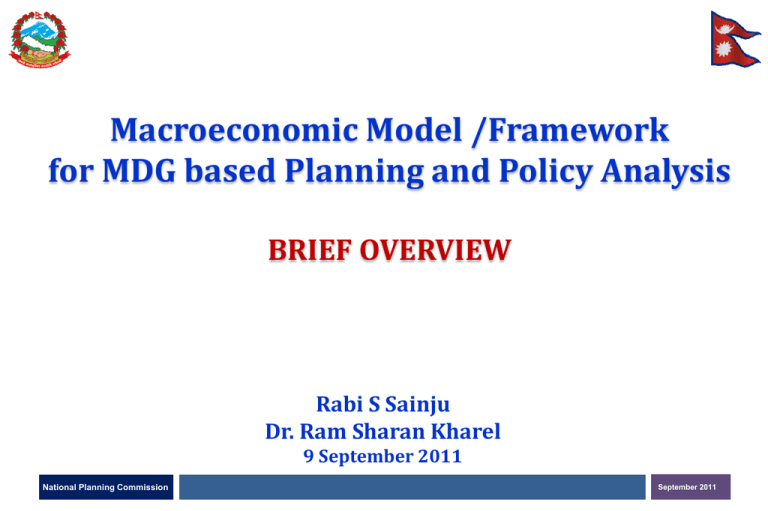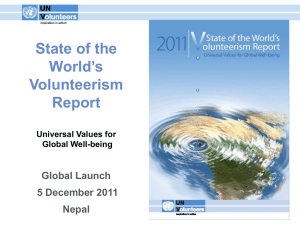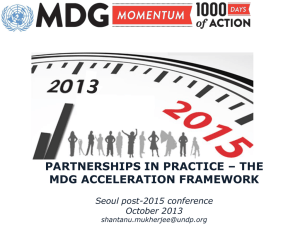Macroeconomic Model - National Planning Commission
advertisement

Macroeconomic Model /Framework for MDG based Planning and Policy Analysis BRIEF OVERVIEW Rabi S Sainju Dr. Ram Sharan Kharel 9 September 2011 National Planning Commission September 2011 Presentation Outline 1. A brief Overview: MDG consistent Macroeconomic framework (MF) 2. Need for a macroeconomic model for MDG based planning 3. Commonly used modeling approaches 4. Best strategy in model building 5. MF process and steps National Planning Commission September 2011 1. A Brief Overview: MDG consistent Macroeconomic framework (MF) National Planning Commission September 2011 MDG consistent MF MDG-consistent MF is the framework that provides a set of sectoral projections consistent with each other and also with macroeconomic goals and policies, and takes into account the level and composition of investment required to achieve MDG targets and its potential effect on the economy. National Planning Commission September 2011 Examples of MDG consistent macroeconomic framework Projections of real sector • i.e. growth, consumption, investment, • need to be consistent with projections of fiscal, monetary and external sectors and MDG targets Projections of fiscal accounts • i.e. revenue, expenditures, fiscal balance • need to be consistent with real, external, and monetary sector projections and MDG financing requirements. National Planning Commission September 2011 • Sectoral projections need to be consistent with national development goals and targets such as growth, poverty, inflation, etc. • Investments based on MDG NA may create some imbalances among macro variables. • Developing MDG consistent macroeconomic framework is a process to provide policy options to address it. National Planning Commission September 2011 Objectives of MDG consistent MF • Provide input for preparing MDG based long term development planning • Strengthen coherence between planning and MTEF/budgetary framework • Provide a monitoring & evaluation framework • Support the national policy dialogue & negotiations with development partners National Planning Commission September 2011 Macroeconomic Model • Macroeconomic models are numerical representations of economic theory, intuition and data. • They highlight the important linkages and transmission mechanisms in the economy • They provide a consistent framework within which behavioural relationships are stored and policy issues examined. National Planning Commission September 2011 2. Need for a Macroeconomic Model for MDG based planning National Planning Commission September 2011 Need for a Macroeconomic Model • Socio-economic variables interact in a complex manner; a macroeconomic model helps to understand the complex interaction • It helps in developing a MDG consistent macroeconomic framework which is key for formulating MDG based national plans. • It also helps in undertaking ex-post and ex-ante policy impact assessment and monitoring which are key for designing MDGs oriented policies/strategies. National Planning Commission September 2011 • It complements the work on MDG sectoral need assessments towards preparing MDG based plan • Because it analyze the impact of scaling up expenditure and assesses the ‘absorptive capacity’ of the economy • It is also useful in addressing some emerging issues such as the impact of crude oil and food price increases. National Planning Commission September 2011 3. Commonly used Modeling Approaches National Planning Commission September 2011 Major Approaches in Macroeconomic Modelling APPROACH Macro econometric Approach (i.e., ME Models) Computable General Equilibrium Approach (i.e., CGE Models) Note: Focuses on modeling approaches, not on specific models National Planning Commission September 2011 Main purpose is 1. to produce short-term forecasts or long-term outlook Macro econometric Approach (i.e., ME Models) National Planning Commission 2. policy evaluation. Main strength lies in their ability to estimate robust parameters Main weakness is that the parameters may not properly capture the changes in the policy regime. September 2011 Computable General Equilibrium Approach (i.e., CGE Models) National Planning Commission • CGE modeling is aimed to incorporate micro behavior into macroeconomic analysis • Main purpose is policy evaluation. • But are complex and datademanding (detailed input-output matrix for a year) September 2011 Choosing Among Approaches No single economic model or approach can fully capture all the interactions and impacts Different models are designed for different purposes A model must ultimately be judged on whether it answers the questions it was designed to answer No “One Size Fits All” Model National Planning Commission September 2011 4. Best Strategy in Model building National Planning Commission September 2011 • Start small: Go small to large • Start simple: Go from simple to complex • Choose approach (ME or CGE models) depending upon objectives and data availability • Choose software (EViews, Vensim, Gams) depending upon model types • Keep it transparent – avoid any ‘black-box’ syndrome • Develop several models instead of try to address all issues by one model • Have always two versions of the model: one operational and another in development National Planning Commission September 2011 Roll-out Experience of MF in Asia and the Pacific • MF has already been applied in Bhutan and Mongolia. • In Bhutan, the model has been used for the preparation of 10th Five-Year Plan. • In Mongolia, the model has been used for formulation of MDG strategies and MTEF • Key aspects of the SMF roll-out are given below: National Planning Commission September 2011 MF Initial considerationswhat we wanted • A simple projection/policy evaluation model taking into consideration of the specificities of LDCs • Capable of analyzing MDG resource needs and policy options in an integrated framework • Comprehensiveness – enough disaggregation in the real and fiscal sectors to analyse the macroeconomic impact of scalingup of public expenditures • Long-Term perspective until 2015 • User-friendliness and local expertise National Planning Commission September 2011 MF Initial considerations – what we decided • A Macroeconometric structural Model because that is what commonly used for long term projection/scenarios analysis • By using EViews software because that is what commonly used for ME structural models • Production disaggregated into 3 sectors – agriculture, industry and services. • Prices/inflation disaggregated into 3 components. • Government Revenue disaggregated into 5-7 categories • Government expenditure disaggregated into 7-8 sectors – in line NA sectors classification. National Planning Commission September 2011 5. MF Process and Steps National Planning Commission September 2011 MF Process Aimed to build national capacity Transparent Can be reviewed and updated periodically National Planning Commission Part of ongoing planning exercises Nationally owned September 2011 • SMF is need to be implemented jointly by national teams (policy makers and researchers) NPC and NRB modelling experts • Train country teams in analytical methodology and computer software • Adaptation to country requirements • Knowledge sharing through national level experts workshops • Continuous technical back stopping by national experts. National Planning Commission September 2011 MF Steps (8 Steps) Step 1: Step 2: Step 3: Step 4: Step 5: Step 6: Step 7: Step 8: National Planning Commission Specifications of the Model Data collection and Assessment Parameters Estimation Solving the model for historical period Historical Validation Choice of Scenarios (BAU, MAG, etc) Link SMF with MDG NA and provide input for MDG based plans Link SMF with on-going long/medium term planning process and provide inputs for budgetary and planning process September 2011 Step 1: Specifications of the Model National Planning Commission September 2011 Step 1: Specifications of the Model (1) Real sectoral GDP Real private consumption Real government consumption Real private fixed investment Land Real GDP Govt Revenue Real GDP inflation Labour & capital Productivity National Planning Commission Inflation Interest rate Inflation and its own lag Public investment Public expenditure interest rate Net domestic credit Inflation September 2011 Variables Determined by Sectoral GDP deflators Money supply, import prices and (inflation) imbalances in the supply & demand. Prices of other items GDP deflator (consumption, investment, exports and imports) Money supply Identity of domestic credits to private and public sectors, net foreign assets, etc. Net foreign assets CAB, exchange rate, and its own lag Net domestic credit to Fiscal balance and real GDP the public sector Net domestic credit to Real GDP and interest rate the private sector National Planning Commission September 2011 • Sub-components of tax revenue are determined by their respective tax rates and tax bases • Sub-components of non-tax revenue are estimated by linking nominal GDP in industry and services • Sub-components of government expenditure are determined on the basis of availability of government revenue, grants, and public borrowing. • Fiscal balance is obtained by subtracting expenditure from revenue National Planning Commission September 2011 Variables Determined by Disaggregated Domestic output, world GDP, relative nominal exports price (domestic price vs. external price), exchange rate, and capital goods imports. Disaggregated Exchange rate and net forex resource nominal imports availability after deducting the interest and other payments CAB Trade balance, net foreign income (dividends, interest) and current transfers (ODA, remittances, etc National Planning Commission September 2011 • Labour supply is determined through population growth and labour force participation rate. • Labour demand is estimated through sectoral GDP growth, wages and technology • Labour productivity is determined through public expenditure on education and health in order link MDG investment with real sector. Disaggregated social (including MDGs) sector model depends upon the data availability. National Planning Commission September 2011 Overview of the NPC Model Blocks Behavioural Equations Identities/ Linking equations Total Number of Equations Real sector Price Block Fiscal Sector Monetary Sector External Sector Social sector Including labour markets/ MDGs Total Number of Equations National Planning Commission September 2011 Step 2: Data collection and Assessment National Planning Commission September 2011 Data Requirements & Assessment • GDP and its components: sectoral value added, personal consumption, government consumptions, private investment, and public investment • Prices: deflator for GDP components • Revenue: taxation, non-taxation, and grants • Expenditure: Expenditure by sectors • External trade: exports, imports, exchange rate, • Monetary: money supply, net foreign exchange asset, net domestic credit to private and public sectors, interest rate, • Social sector: Poverty, Gini ratios, HDI, literacy rate, life expectancy rate, population, labour and employment National Planning Commission September 2011 Data Collection & Consistent Checking • Required data collected or compiled from variety of sources • Preferences given to government publications • Wherever data not available from government sources readily, then the required data are obtained from ADB and World Bank database • Data are checked for consistency as well as for stationary National Planning Commission September 2011 Step 3: Parameters Estimation • All equations were estimated in a linear form by using OLS method • Non-stationary variables have been estimated by using first differences or Error Correction Method (ECM). • Diagnostic testing has been done by using standard methods such as ‘R2’ for goodness of fit, ‘t’ statistics for significance of coefficients, ‘D.W’ test for serial correlation, ‘RMSPE’ for model reliability, etc. • Dummy variables have been used frequently to take care of data outliers National Planning Commission September 2011 Step 4: Solution of the model • The model specified in the step 1 updated with estimated parameters • Model was then solved for 1996-2010 to assess the performance National Planning Commission September 2011 Step 5: Historical Validation • Comparison of actual and estimated values for the period 1996-2010 • Error (RMSPE) values are less than 10 % for most of the variables • Errors are relatively small for key indicators such as GDP, inflation, total revenue, total expenditure, exports, imports, etc. • Errors are relatively large for non-tax revenue, credit to public sector, expenditure on public works, fiscal deficits, trade balance, and savings. National Planning Commission September 2011 Step 6: Choice of Scenarios • ‘Business-as-usual’ simulation can be used as Base line for comparison • MDG NA simulation – to examine the possible impact of scaling up public expenditure on the economy. • Other policy simulations – e.g., tax reforms simulation to assess the potential scope of rising domestic resources to meet the MDGs National Planning Commission September 2011 Step 7: Linking MF with MDG NA estimates National Planning Commission September 2011 • Aim is to prepare MDG consistent macro framework, we need link MF with MDG NA estimates • This will indicates 1. Macro economic implications of MDG NA related investment 2. Economic growth rate (and its distribution) require to achieve income poverty targets 3. Help in developing comprehensive MDG financing strategy National Planning Commission September 2011 NA Cost Linked with MF Sectoral Equation Education, health and agriculture Public expenditure Gender and capacity development General administration expenditure Roads, water and sanitation Public works expenditure Energy and environment Public expenditure for trade, industry and power National Planning Commission September 2011 Step 8: Linking MF with Budgetary Framework • Long term MDG consistent MF can provide inputs for formulation of medium term fiscal and expenditure framework (MTFF, MTEF) through longer term revenue, expenditure and investment projections Undertaking policy simulations to prioritizepublic investments National Planning Commission September 2011 Nepal MF Key Findings Parameters estimation for the period 1975-2010 shows that National Planning Commission September 2011 Lessons learnt • Data problems require that the model needs to be simple • Robust parameters needed for generating MDG consistent macroeconomic framework • Macroeconomic modeling works in Bhutan, Mongolia and Sri Lanka confirm that a variety of approaches are needed for MDG based plans • This model has been designed to keep it a flexible platform, so that it could be used for (i) MDGs analysis, (ii) medium/short-term planning and budget formulation and (iii) analysis of growth, fiscal space, and emerging issues National Planning Commission September 2011 Agenda for further work Providing technical input to MTFF process by adding a few more equations in the model to capture balance of payments and disaggregation of real sector National Planning Commission Extending MF to encompass poverty and income distribution outcomes of MDG/TYP investment. Imparting another round of training to core staff working on planning and budgetary framework September 2011 Agenda for Future work More disaggregated modelling particularly in real sector National Planning Commission Improving modelling Re strengthening social/MDG module Adding more modules (gender, environment, and energy) Linking with households surveys to account for poverty and inequality impact Explore sectoral or satellite modelling approach September 2011 Thank you for your attention National Planning Commission September 2011







